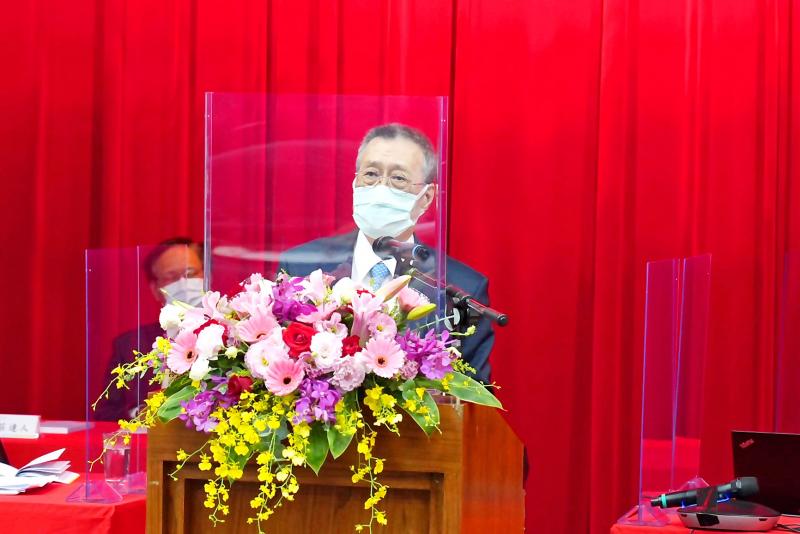Nanya Technology Corp (南亞科技) has received government grants to build a new NT$300 billion (US$10.17 billion) fab after a nine-month deferral primarily due to red tape, as well as shortages of labor and raw materials.
The chipmaker yesterday sent media an invitation to attend a groundbreaking ceremony for the 12-inch fab on June 23.
Nanya Technology expects the fab, to be built in New Taipei City’s Taishan District (泰山), to start commercial operations in 2025.

Photo courtesy of Nanya Technologies Corp
It had expected the fab to start operations in 2024 with a monthly capacity of 15,000 wafers.
The new factory would help Nanya Technology solve capacity bottlenecks, it said.
The chipmaker expects production this year to be little changed for a second year, after a 35 percent year-on-year expansion in 2020.
With the introduction of more advanced technologies, the new fab would help it broaden its product portfolio and expand its customer base, the company said when it unveiled the plans in April last year.
The firm yesterday said that it plans to ramp up production of its first-generation 10-nanometer process technology in the second half of this year, allowing it to offer an 8-gigabyte DDR4 DRAM, among other memory chips.
A second chip, a DDR5 DRAM, is entering pilot production using 10-nanometer technology, Nanya Technology chairman Wu Chia-chau (吳嘉昭) told the company’s annual shareholders’ meeting yesterday.
The 10-nanometer chips are expected to account for 10 percent of total output by the end of this year at the earliest, it said.
The company currently uses mostly 20-nanometer technology to make DRAM chips.
Cloud-based data centers are leading the uptrend in DRAM chip demand, while rising 5G smartphone penetration is also boosting consumption, Wu said, adding that commercial and gaming notebooks are also growth drivers.
However, rising inflation worldwide, geopolitical tensions and supply constraints for key components are dampening demand for consumer laptops and handsets, he added.
The firm’s shareholders at the meeting approved a cash dividend of NT$3.7 per common share, which represents about a 50 percent payout ratio compared with last year’s earnings per share of NT$7.4.

BYPASSING CHINA TARIFFS: In the first five months of this year, Foxconn sent US$4.4bn of iPhones to the US from India, compared with US$3.7bn in the whole of last year Nearly all the iPhones exported by Foxconn Technology Group (富士康科技集團) from India went to the US between March and last month, customs data showed, far above last year’s average of 50 percent and a clear sign of Apple Inc’s efforts to bypass high US tariffs imposed on China. The numbers, being reported by Reuters for the first time, show that Apple has realigned its India exports to almost exclusively serve the US market, when previously the devices were more widely distributed to nations including the Netherlands and the Czech Republic. During March to last month, Foxconn, known as Hon Hai Precision Industry

Taiwan Semiconductor Manufacturing Co (TSMC, 台積電) and the University of Tokyo (UTokyo) yesterday announced the launch of the TSMC-UTokyo Lab to promote advanced semiconductor research, education and talent development. The lab is TSMC’s first laboratory collaboration with a university outside Taiwan, the company said in a statement. The lab would leverage “the extensive knowledge, experience, and creativity” of both institutions, the company said. It is located in the Asano Section of UTokyo’s Hongo, Tokyo, campus and would be managed by UTokyo faculty, guided by directors from UTokyo and TSMC, the company said. TSMC began working with UTokyo in 2019, resulting in 21 research projects,

Taiwan’s property market is entering a freeze, with mortgage activity across the nation’s six largest cities plummeting in the first quarter, H&B Realty Co (住商不動產) said yesterday, citing mounting pressure on housing demand amid tighter lending rules and regulatory curbs. Mortgage applications in Taipei, New Taipei City, Taoyuan, Taichung, Tainan and Kaohsiung totaled 28,078 from January to March, a sharp 36.3 percent decline from 44,082 in the same period last year, the nation’s largest real-estate brokerage by franchise said, citing data from the Joint Credit Information Center (JCIC, 聯徵中心). “The simultaneous decline across all six cities reflects just how drastically the market

Ashton Hall’s morning routine involves dunking his head in iced Saratoga Spring Water. For the company that sells the bottled water — Hall’s brand of choice for drinking, brushing his teeth and submerging himself — that is fantastic news. “We’re so thankful to this incredible fitness influencer called Ashton Hall,” Saratoga owner Primo Brands Corp’s CEO Robbert Rietbroek said on an earnings call after Hall’s morning routine video went viral. “He really helped put our brand on the map.” Primo Brands, which was not affiliated with Hall when he made his video, is among the increasing number of companies benefiting from influencer